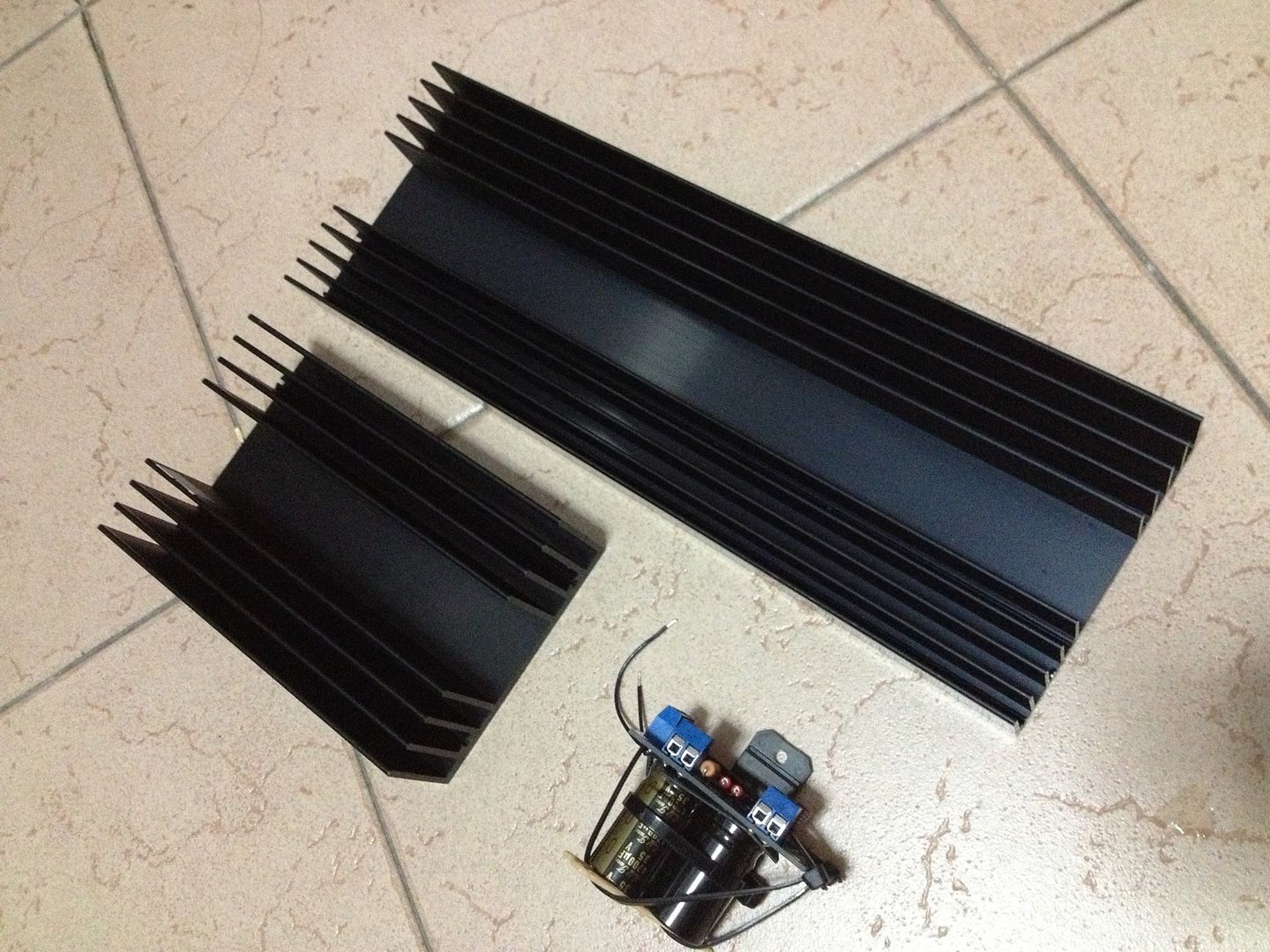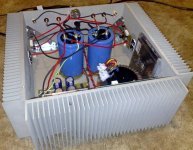Sorry for yet another heat sink question.
Initially I bought the larger heat sink for a LM4780 and the smaller one for LM3886TF.

As size comparison LM3886 and its board are included in the picture. The exact heat sink dimensions are:
Larger: 300x100x26mm
Smaller: 150x92x40mm
However, I wonder if I can get by with both chips on the larger heat sink? The heat sink is going to be mounted externally on top of the chassis.
Transformer voltage: 2x18V
Load for LM3886: 1x4Ω speaker
Load for LM4780: 2x4Ω speaker (in stereo mode)
Ambient temperature: Lets assume ~28-30˚C
Thanks.
Initially I bought the larger heat sink for a LM4780 and the smaller one for LM3886TF.

As size comparison LM3886 and its board are included in the picture. The exact heat sink dimensions are:
Larger: 300x100x26mm
Smaller: 150x92x40mm
However, I wonder if I can get by with both chips on the larger heat sink? The heat sink is going to be mounted externally on top of the chassis.
Transformer voltage: 2x18V
Load for LM3886: 1x4Ω speaker
Load for LM4780: 2x4Ω speaker (in stereo mode)
Ambient temperature: Lets assume ~28-30˚C
Thanks.
The heatsink is best mounted so that the fins are orientated so that air freely circulates up the fins due to natural convection. With a huge heatsink that shouldn't be too much of an issue but I would "birds nest" run the amps on their heatsinks to see how warm they get before mounting everything into a case.
Thanks guys. 🙂
Note: the bigger heat sink has a shorter fin length.
By "birdnest" I assume you mean the fins on top and the flat side underneath?
I would really prefer a heat sink that has its fins oriented the other way. But since it would be obscenely tall if I mount it standing, the only other way would be to mount it "birdnest" style on top of the chassis.
Note: the bigger heat sink has a shorter fin length.
By "birdnest" I assume you mean the fins on top and the flat side underneath?
I would really prefer a heat sink that has its fins oriented the other way. But since it would be obscenely tall if I mount it standing, the only other way would be to mount it "birdnest" style on top of the chassis.
Last edited:
You sure can!
You sure can not !
A heatsink like that is efficient up to 100-150mm length max.
Beyond that length, it brings absolutely nothing to the table, expect in the order of 1.5 C/W at best. (need a reference ? )
Mounted flat on top of the case, thermal efficiency turns a lot worse.
Especially this one, due to few ribs, with only 4/5th of an inch rib height.
Raises the number to above 2C/W.
18V transformer => ~25V rails (assume 25C ambient, numbers will be worse for 30C )
LM3886 datasheet => 3C/W heatsink
LM4780 datasheet => < 1C/W heatsink (for 2 channels)
1/3 + 1/1 = 4/3 W/C => 0.75 C/W Heatsink !
Last edited:
26mm is more than an inch?
And would that calculation stands with more than 1 heat sources? If the heat sink has a rating of 2˚C/W with heat radiating from a single point, surely the rating can not be the same with the same amount of heat radiating from opposite ends especially with such a long dimension (you said efficiency tops at 100-150mm)?
And would that calculation stands with more than 1 heat sources? If the heat sink has a rating of 2˚C/W with heat radiating from a single point, surely the rating can not be the same with the same amount of heat radiating from opposite ends especially with such a long dimension (you said efficiency tops at 100-150mm)?
Thanks guys. 🙂
Note: the bigger heat sink has a shorter fin length.
By "birdnest" I assume you mean the fins on top and the flat side underneath?
I would really prefer a heat sink that has its fins oriented the other way. But since it would be obscenely tall if I mount it standing, the only other way would be to mount it "birdnest" style on top of the chassis.
Birdnest means just connect it up as a mass of wires and see how it works best.
Vertical finned heatsinks are designed and specified for vertical fin orientation !!!!!!!
Andrew, I phrased my post to try and prevent confusion. Vertical fins can be read as lying on its back. The fins need to be, as the OP suggested, in the obscenely high orientation.
Vertical finned heatsinks are designed and specified for vertical fin orientation !!!!!!!
When the fins are pointing up, does it count as "vertical fin orientation"? 😀
26mm is more than an inch?
26mm is rib height plus base thickness.
With a base thickness of 4-5mm at the least, the ribs have a max height of 22mm.
1 inch is 25.4mm , 22mm is about 4/5 inch. (1mm more or less hardly makes a difference)
It would make a difference if you chopped the heatsink in 2, mounted a chip on each of them, and placed the heatsinks side by side, vertically.
They way you intend to position the large heatsink, the numbers I mentioned (from the datasheets) are pretty much valid if you place the 3886 and 4780 at 1/4th length from the ends (1/4-2/4-1/4)
Place them side by side, and the outcome will be worse.
(btw, just adding up the output power numbers of both amp chips is sufficient to estimate the heatsink C/W. Chip or discrete makes little difference, still class AB amp)
Have a look =>
Attachments
Last edited:
NO the thick part, the back of the heatsink with the devices mounted onto it should be vertical. The fins need to be orientated so that they are also vertical, not on its back. You actually reduce the heatsink efficiency by more than 50% by mounting it like a hedgehog.
What Jacco has illustrated above is what you should se if you are lying on the floor looking up through the heatsink.
Thanks guys, understood. 🙂
Can you explain this?
Say for LM4780, it is rated at about 120W into 4Ω. We assume 120W dissipation? Say I want to limit thermal increase to 40˚C (already quite hot). So 40÷120=0.33C/W? The internal thermal resistance of the chip is already more than this so I can't be right.
From the photos in the build thread, most builds seem to use heat sink smaller than my small heat sink per chip.
btw, just adding up the output power numbers of both amp chips is sufficient to estimate the heatsink C/W. Chip or discrete makes little difference, still class AB amp)
Can you explain this?
Say for LM4780, it is rated at about 120W into 4Ω. We assume 120W dissipation? Say I want to limit thermal increase to 40˚C (already quite hot). So 40÷120=0.33C/W? The internal thermal resistance of the chip is already more than this so I can't be right.
From the photos in the build thread, most builds seem to use heat sink smaller than my small heat sink per chip.
18Vac transformer => 50-55W in 4 ohm.
Goes both for LM3886 and LM4780.
3 channels : 150W to 165W.
150W output power requires a heatsink of < 1 C/W.
Doesn't even require a datasheet.
It's not an accurate number, for that, one needs to do the calculations.
Just common sense, also an easy check to verify the outcome of calculus.
I had a blind date once, looked real nice, sexy dame even, till it turned out something 'more'.
(at tech university, I learned to use my head first, calculator second, and never to put all faith in digits on a screen, or pictures)
Goes both for LM3886 and LM4780.
3 channels : 150W to 165W.
150W output power requires a heatsink of < 1 C/W.
Doesn't even require a datasheet.
It's not an accurate number, for that, one needs to do the calculations.
Just common sense, also an easy check to verify the outcome of calculus.
I had a blind date once, looked real nice, sexy dame even, till it turned out something 'more'.
(at tech university, I learned to use my head first, calculator second, and never to put all faith in digits on a screen, or pictures)
Last edited:
But you are running audio, not CW power, so your average power is going to be much lower then 120W, general audio design assumes 1/8th maximum power for thermal calculations, so heatsinks can be lot more reasonable.
A delta T of 40 degrees at the heatsink means the junction will be running much hotter then that, so do a calculation assuming the heatsink is at say 80 degrees (40 degrees ambient plus 40 degrees delta T, and work back to the junction temperature from the power dissipated and the sum of the hermal resistances junction to case, and case to heatsink, 100 degrees C Tj is reasonable, 125 is pushing it unless the data sheet says otherwise (And check the effect on MTBF at elevated temperatures).
You will find that if running high power then the surface flatness and clamping forces used are critical, and most extruded heatsinks really benefit from having a face mill run across the interfacing area as they are seldom flat.
Regards, Dan.
A delta T of 40 degrees at the heatsink means the junction will be running much hotter then that, so do a calculation assuming the heatsink is at say 80 degrees (40 degrees ambient plus 40 degrees delta T, and work back to the junction temperature from the power dissipated and the sum of the hermal resistances junction to case, and case to heatsink, 100 degrees C Tj is reasonable, 125 is pushing it unless the data sheet says otherwise (And check the effect on MTBF at elevated temperatures).
You will find that if running high power then the surface flatness and clamping forces used are critical, and most extruded heatsinks really benefit from having a face mill run across the interfacing area as they are seldom flat.
Regards, Dan.
Just common sense...
That is the whole point of this thread. 😀
I presume if I have build dozens of these things, I can take a look at a heat sink and tell if it is enough. There are datasheets, but the heat sink doesn't come with one, so that is moot.
The best I could do is to Google and browse the build thread here and make an estimation of the size of the heat sink that people use. And that is how I came home with these heat sinks. And I rarely see a build with a heat sink bigger.
A heatsink will never be too big.
Like you can never have too much money? 😀
- Status
- Not open for further replies.
- Home
- Amplifiers
- Chip Amps
- Another heat sink size question

